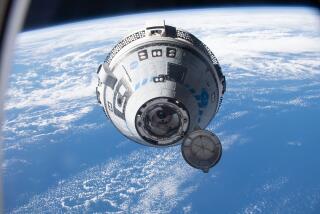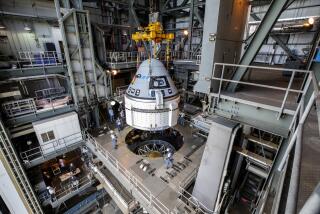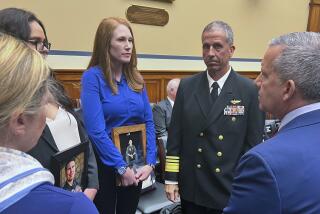Tougher Wing Inspections Urged for Shuttle
WASHINGTON — The Columbia accident board, in its initial recommendations to help prevent another space shuttle disaster, on Thursday urged NASA to improve inspections of a key heat-resisting material on the orbiters’ wings.
Potential problems with one of Columbia’s wings are a focus of the investigation into the craft’s disintegration during reentry on Feb. 1.
The accident board also called on NASA to get more pictures of the shuttles when they are in space.
NASA Administrator Sean O’Keefe swiftly embraced the proposals. He said engineers are studying the wing inspection issue. And he noted that the photo recommendation already has been addressed under a new agreement with a U.S. intelligence agency that operates spy satellites.
The two suggestions are just the first of many expected from the Columbia Accident Investigation Board. “We intend to act on every single one of their recommendations, without fail,” O’Keefe said.
Thursday’s recommendations, issued in advance of a final report expected this summer, come at a critical moment for NASA. The three remaining shuttles have been grounded indefinitely while investigators hunt for the cause of the Columbia disaster.
On April 26, to fill in for the absent U.S. orbiters, Russia will launch a Soyuz spacecraft with an astronaut and a cosmonaut onboard to replace a three-man crew now aboard the international space station.
The launch is part of a series of manned and unmanned flights planned by Russia to help maintain the space station while the shuttle fleet remains grounded.
But U.S. officials are eager to put the shuttle fleet back into service quickly to resume construction of the $100-billion station and bolster its capacity to perform scientific experiments. The shuttles can carry far more cargo and a larger crew than the Soyuz vehicles.
Under the most optimistic timetable, O’Keefe said during a luncheon at the National Press Club, shuttles would fly again by year’s end. That is slightly later than a tentative plan to resume flights by the fall that NASA previously announced.
How quickly NASA can restart the shuttle fleet depends largely on the findings of the accident board.
The panel, headed by retired Navy Adm. Harold W. Gehman Jr., is investigating whether pinholes and hidden breaches in Columbia’s left wing allowed superheated gas to penetrate the orbiter and cause it to blow apart. Investigators are also seeking to determine whether such possible defects were worsened during Columbia’s Jan. 16 liftoff, when chunks of foam insulation fell from an external fuel tank and struck the wing.
To help prevent disasters, the board said Thursday that NASA should intensify its inspections of a “reinforced carbon-carbon” thermal protection system. That composite material protects the critical leading edge of the shuttles’ wings.
Under current procedures, shuttle technicians typically inspect the carbon-carbon lining by eye and hand, said Michael A. Greenfield, NASA’s associate deputy administrator for technical programs. They also take a closer look when the shuttles are overhauled every few years.
The accident board said “current inspection techniques are not adequate to assess structural integrity of [the reinforced carbon-carbon], supporting structure and attaching hardware.”
Greenfield said NASA and its contractors are considering new X-ray, ultrasonic or thermographic tests that could yield more information about the heat-shielding system. He added: “This is very difficult material to inspect.”
In its other recommendation, the board took note of a controversy that has dogged NASA officials for weeks: the lack of photos of Columbia during its final mission that might have alerted the agency to the impending disaster.
Despite the U.S. government’s ability to photograph the shuttles using ground telescopes and spy satellites, the board found that “there were no on-orbit images taken of sufficient resolution to assess the orbiter’s condition.”
Internal e-mails have shown that NASA officials debated whether to seek images of the shuttle, but they ultimately concluded not to request such help from military and intelligence agencies. NASA officials said they had concluded that the shuttle was not at risk.
O’Keefe on March 28 announced an agreement with the National Imagery and Mapping Agency in which that agency will routinely take pictures of shuttles when they are in orbit. The board’s recommendation Thursday essentially endorsed O’Keefe’s move.
The board’s 13 members issued no statements elaborating on their two written proposals.
O’Keefe cautioned that investigators have not yet determined the cause of the accident. But he said that so far, the investigation has diverged sharply from the one that followed the 1986 Challenger disaster. In the first accident, he said, investigators found an obvious culprit: the failure of a brittle “O-ring” joint on a solid rocket booster. By contrast, he said, multiple factors may lie behind the Columbia disaster.
“What is clearly unfolding here is a very long string of events and circumstances which led to this particular tragedy,” O’Keefe said. “And they still aren’t certain what caused it, what the first precipitating event was. Certainly, [there are] scenarios and theories, but not a conclusion of what may have done this.”
He added: “This will likely be a combination of hardware failures, process failures and judgment calls.”
More to Read
Sign up for Essential California
The most important California stories and recommendations in your inbox every morning.
You may occasionally receive promotional content from the Los Angeles Times.










